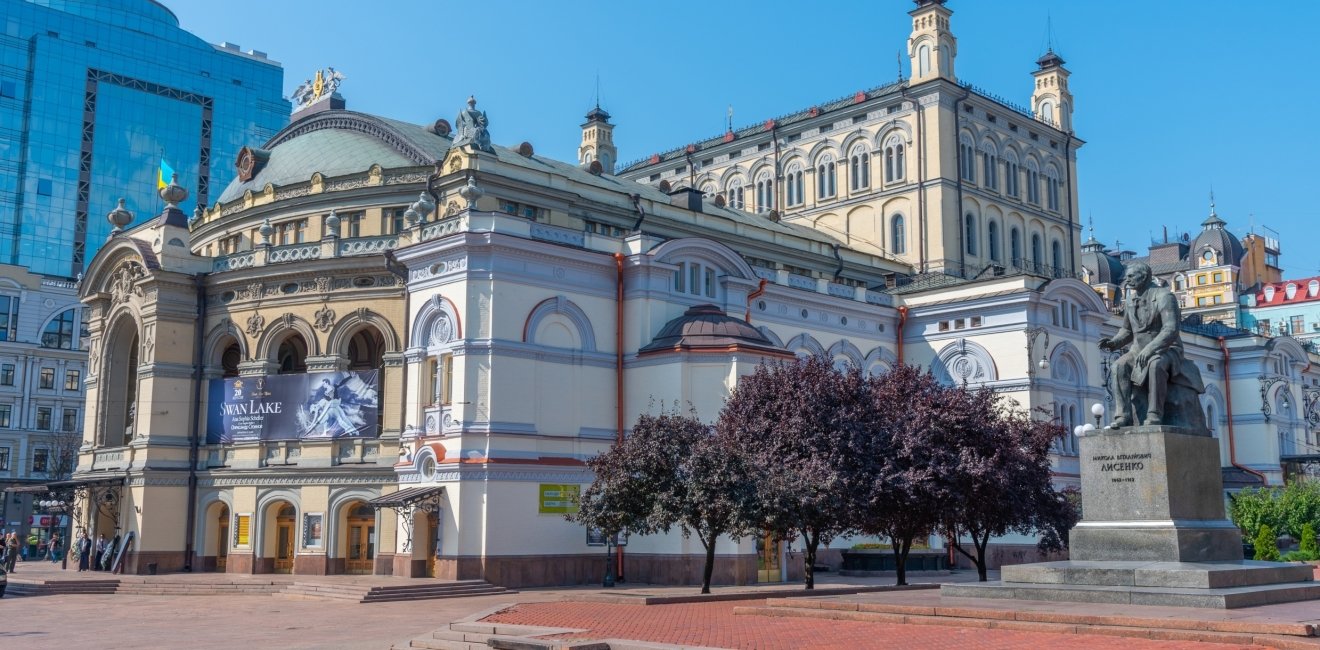
A blog of the Kennan Institute
BY BLAIR A. RUBLE
Among the many astonishing images flowing out of Ukraine since the beginning of the war, one remarkable video proclaimed the resilience of the human spirit through music. Several members of the Kyiv Symphony Orchestra took advantage of a brief cease-fire in the otherwise unrelenting Russian attack on their city to provide a surprise concert for their beleaguered neighbors in the capital’s central Independence Square. Led by conductor Herman Makarenko, the hearty musicians played a selection of uplifting music, including the Ukrainian national anthem and Beethoven’s “Ode to Joy.” This inspiring performance proclaimed louder than words that Kyiv still lives.
Such an outpouring of music might have been surprising in many cities around the world, but not in Kyiv. Like other major metropolises, Kyiv has had a vibrant music scene revolving around all levels of musicianship and genres. The city long has been a place where music-lovers can find whatever they are seeking.
Formally, the city has always provided plentiful opportunity for young musicians to share their craft with others. Bartolomeo Rastrelli’s Baroque masterpiece from the 18th century—St. Andrews Church—towers over the city’s skyline from its perch on the steep slopes of its namesake, Andriivskii Descent. Its weekly concert series offers an exquisite setting for up-and-coming classical musicians to win over an audience.
Kyiv’s very identity, however, is infused with musicality. Bring a few Kyivians together and music is not far behind. I had firsthand experience with the ubiquity of music in Kyiv a while back when I was exiting the central Teatralna metro station.
A major transfer point between north-south and east-west subway lines, the station bustles in peacetime, with passengers scurrying about to catch their trains or exit into downtown. Dating from the 1960s, the station boasts many of the features that marked Soviet metro systems of the era that favored grandeur over efficiency. But the main ticket hall of granite and marble offers a perfect dance hall as well.
While exiting the station one Monday evening, I began to hear Ukrainian folk music. As I was riding the escalator up from the platforms to the turnstiles, I didn’t pay particular mind, as performers frequently appear in Kyiv’s subway system to earn some cash. But the music began to sound rather different from what I normally would hear on the metro. As I stepped through the turnstiles into the ticket hall, I found myself in a music hall.
The band consisted of five musicians with an accordion and various accompanying instruments. Around them danced about 40 couples, nearly all of whom were of pensioner age. Pensioners can ride the metro for free, and the station’s various lines enable them to travel from all corners of the city to meet. Obviously, everyone had come knowing there would be a party and everyone was having a good time. Other riders—intent on getting home or to some appointment or other—passed through the dancing crowd effortlessly.
Moving around the city I often stumbled across musical happenings of all sorts. The sound of bagpipes emerged from central metro stations from time to time, while Peruvian musicians added a touch of the Americas to central Kyiv streets. Free pianos near the entrance to the Funicular running down to the lower city always seemed to attract skillful players. In the hipster neighborhood of Podil, the instrumentation might be electrified. An assortment of string instruments might accompany fine weather in Mariyinsky Park. There might be saxophones near the Golden Gates. Kyivians have not just turned to music for entertainment, remembrance, or celebration. They live carrying music around with them, ready for any occasion.
The city’s musicality provides an important spiritual resource that requires no official or commercial sanction. Music is there—as in the middle of a brutal invasion—to provide courage, encouragement, and solace. This musicality similarly explains Kyivians’ ability to reach out to one another despite whatever separates. Music becomes an essential bond that transcends difference.
Music’s power is within us all and can be felt everywhere. In cities like New Orleans, Vienna, and Buenos Aires that are fortunate enough to have defined their identify through music, performance becomes a core strength able to withstand the worst of times. Such music reminds us of the past, but it can also remind us that what might seem irrevocably lost may be found again.
The opinions expressed in this article are those solely of the authors and do not reflect the views of the Kennan Institute.
Author

Former Wilson Center Vice President for Programs (2014-2017); Director of the Comparative Urban Studies Program/Urban Sustainability Laboratory (1992-2017); Director of the Kennan Institute for Advanced Russian Studies (1989-2012) and Director of the Program on Global Sustainability and Resilience (2012-2014)

Kennan Institute
After more than 50 years as a vital part of the Wilson Center legacy, the Kennan Institute has become an independent think tank. You can find the current website for the Kennan Institute at kennaninstitute.org. Please look for future announcements about partnership activities between the Wilson Center and the Kennan Institute at Wilson Center Press Room. The Kennan Institute is the premier US center for advanced research on Eurasia and the oldest and largest regional program at the Woodrow Wilson International Center for Scholars. The Kennan Institute is committed to improving American understanding of Russia, Ukraine, Central Asia, the South Caucasus, and the surrounding region through research and exchange. Read more

Explore More in Focus Ukraine
Browse Focus Ukraine
Talking to the Dead to Heal the Living

Ukrainian Issue in Polish Elections


